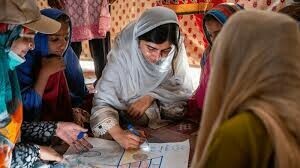
We tell our stories through our work. ‘Seba’, which was exhibited at the Chawkandi Art Gallery recently, showcases Mussarat Arif’s yearning for connection and her cultural and spiritual roots, among other things.
Born and bred in Pakistan, the artist is now based in Houston, America. While Arif’s work has always been a form of catharsis for the artist, through which history and culture intersect, it is also deeply spiritual.
The materials she has used to express her inner story to the outside world — leather, copper, wood, brass, thread and the traditional Sindhi rilli — are symbolic of the lost connections that she yearns for. Connections to her home, her country, her roots and the culture she identifies with.
In ‘Memory’, a piece of beautifully carved Burma teak wood, we see inscriptions, some of which look like lines printed from an old book, with one section utilising the faded calligraphy which is the artist’s forte. Even the material used — Burma teak — is one that’s only found in old, often restored furniture from the pre-Partition era and immediately in the decades following the Partition. There is a pillar and a dome, in the manner found in mosques, carved out of the wood — the reference to the artist’s spirituality takes centre stage here.

‘Into the Past’ uses threads, oil and silver leaves on canvas, with the threads coming together to form a door that opens into a world of Sindhi script. The colour palette follows a dark, deep blue, evoking the feeling of having a memory expressed. The door is the door to the artist’s consciousness, opening into the part of the artist’s existence that has kept this memory safe.
A recent exhibition comes across as a letter of love and yearning for the artist’s culture and homeland
A vertical piece carved from the centre-bottom, similar in style to ‘Memory’, is ‘Hoo’. It’s a piece created in copper with the silhouette of the pillar and a double dome emanating in the middle. In a cloudy, pointy font, Hoo, in the Urdu/Arabic/Farsi script appears all over it, the same way the clouds appear in the next carved copper piece, ‘Fana’. Both are indicative of the artist’s deep spirituality.
Interestingly in the third piece, created along similar lines and titled ‘My Shadow’, there is no carving at all. This copper piece is cut in the same manner as ‘Hoo’ and ‘Fana’, complete with the pillar and double dome, but it remains empty, sans for an uneven shadow around the pillar cut-out — a hint of the artist’s presence. It feels like the artist is in some way looking back at the viewer.

‘Seba’ is unlike the work Arif has exhibited before. As an artist, she’s popularly known for the finesse and beauty of her calligraphic work, done in the Kufic script in intricate designs, not following the linear movement of traditional text. Her work has always been deeply spiritual and, while ‘Seba’ may be unlike her previous work, her spirituality resonates in these pieces as well.
‘Seba’ by Mussarat Arif was exhibited at the Chawkandi Art Gallery from December 6-14, 2022
Published in Dawn, EOS, December 25th, 2022













































Dear visitor, the comments section is undergoing an overhaul and will return soon.